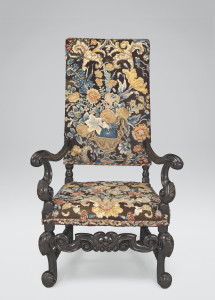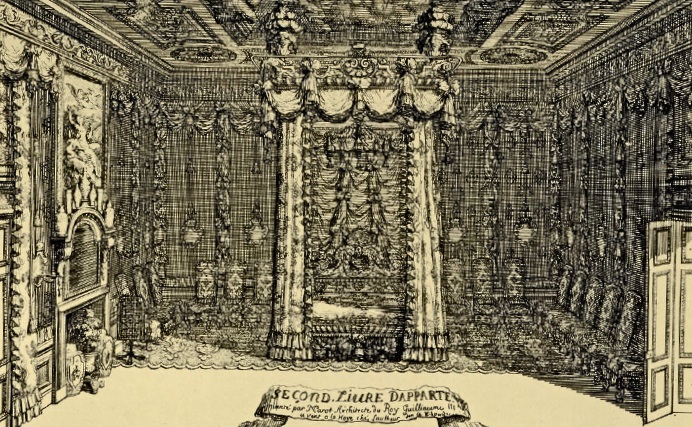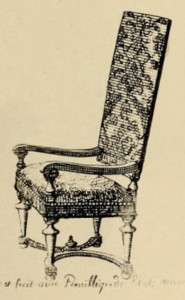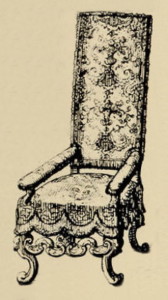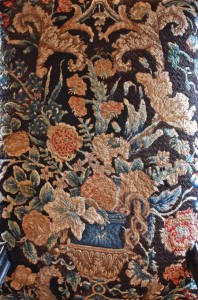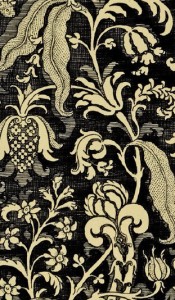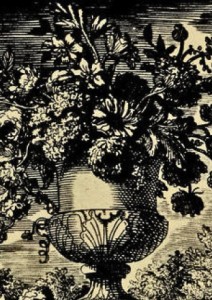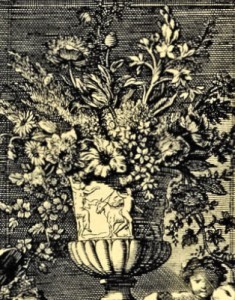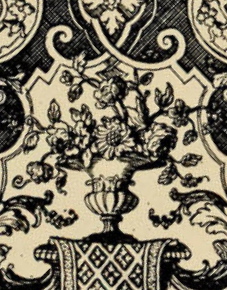by Jenny Saunt
- Chair #7
The chair above is part of a suite originally made for Drayton House in Northamptonshire. Six chairs, a settee and a bed of the same set are still at Drayton, all of which were made between 1700 and 1702.
The early life of this suite of furniture can be followed through a trail of documentary evidence, from the account books and inventories of Drayton House.
Terms for production of the needlework for this suite were defined and agreed in 1700. The excerpt below, dated ‘July the 24th 1700’, mentions the embroidery and reads: ‘is made and agreed upon for the embroidery’, and on the second line, it records the fact that the needlewomen had ‘to find silks and all other things fitting’ – meaning, it was their responsibility to provide all the materials as part of the total cost of the work.
Following this account, there are then various payments for the separate elements of this interior, such as the ‘grate curtain’ for the great bed that matched the chairs. The excerpt below reads: ‘the second grate curtane & I have too guyness in hand to begin the oth on the 12th of december’.
The needlework was provided by ‘Elizabeth Vickson’ and ‘Rebekah Dufoe’, who signed the listed payments as proof of receipt, as shown below.
The life of this set of chairs can then be followed through several household inventory records, below is an inventory description which reads: ‘elbow chairs & a settee of the same as the bed’.
Drayton’s inventories from 1710 and 1724 have been transcribed and published in full in Tessa Murdoch’s Noble Households (2006). In the 1724 inventory there is a description which reads, ‘a fine needlework bed…black elbow chairs with seats and backs of Ditto’
However, despite this wealth of archival evidence for the chairs, it is still uncertain how many of this type of chair were originally made for Drayton House. As already stated, six of the same frame design and needlework cover are currently at Drayton, but there are a further eight in the King’s dinning room there – with identical frame shape but different covers. One more is now a CTF chair and another is part of the V&A collection
Until recently, this was thought to be the whole set, but in the course of research for 100 British Chairs a letter from Phillips of Hitchen to the V&A furniture department has revealed that there are in fact four more of these chairs still in existence somewhere.
In May 1950, Phillips of Hitchen wrote to Ralph Edwards of the V&A furniture department to tell him of a ‘set of six arm chairs from Drayton House at special price of £125 to the Victoria and Albert museum’. The letter goes on to explain about the chairs’ fine ‘needlework covers’ and that they had been bought ‘many years ago’ from the owners of Drayton. Hitchens were just about to exhibit one of these chairs at the Grosvenor House fair of that year. Ralph Edwards immediately bought one of the six, which is still at the V&A along with all its documentation for purchase and delivery from Hitchens, and another of the six is the CTF chair, which still has part of the Hitchens label attached to its frame. The whereabouts of the other four that Hitchens had for sale in 1950 are currently unknown, but with six still at Drayton and six owned by Hitchens in 1950, this makes a total of twelve. Added to the eight chairs of identical frame design but different covers, still at Drayton in the King’s dinning room, the total of this frame type is twenty.
To commission a large set of imposing chairs of this type was the height of grand fashion in the late seventeenth century. Designs of Daniel Marot from this period give a good idea of the effect that was desired. Below, two of Marot’s prints for anonymous rooms of the time show highly coordinated symmetrical interiors, with formally arranged pieces: including tall centrally placed beds, flanked by imposing ranks of needlework chairs on either side.
Marot’s style had impressive theatricality and it closely resembles that of the state bedroom design at Drayton – which is shown in the smaller image below on the left.
In addition, Marot’s chair designs show the same square needlework backs as the Drayton chairs, the same sweeping curve of the arms and the ‘horsebone’ leg and fore rail.
The ‘horsebone’ element of this design has been explored by Adam Bowett in his 1999 article ‘The English ‘Horsebone’ chair 1685–1710’. Bowett untangles the origins of the English description of a ‘broken double scroll’ and investigates surviving documentary evidence for the correct dating of this type of chair.
The ‘horsebone’ is rampant throughout Marot’s work and appears repeatedly in clocks, architecture, furniture, monuments and garden design.
The needlework design prints of Marot also have a close relationship with the Drayton suite, see below.
Urns filled to bursting-point with flowers were a favorite motif with Marot and make frequent appearance in his prints.
Aside from the work of Daniel Marot, the earliest related chairs to this Drayton chair made their first appearance in print in 1687, in the ‘Enthronement of James II and Queen Mary’ (disscussed in Bowet Early Georgian Furniture 1715-1740) where they were given a prominent position at the forefront of the scene.
A Dutch needlework chair – referenced by Peter Thornton with the image below – gives an indication of the original bright colouring of the needlework on the Drayton chairs.
Since being sold from Drayton in the early years of twentieth century, the CTF chair has lived its life in circumstances close to museum conditions, proctecting some of is colour. However, though the six at Drayton appear faded at first glance (below left), when their covers are turned back the orignal viberancy of the needlework colours can still can be seen on the reverse of the fabric (below right).
Furthermore, the discovery of a fragment of this needlework, shown below, which has not been exposed to light for the three hundred years since it was completed, allows a re-imagining of the original impact of the room, in fully saturated Technicolor.
References:
Bruce A. Bailey, Drayton House: Northamptonshire, (Architectural Digest, 1990).
Noble Households: Eighteenth century inventories of great English Houses, Ed. Tessa Murdoch, (John Adamson, Cambridge, 2006), pp. 117-141.
Adam Bowett, ,Early Georgian Furniture 1715-1740, (Antique Collectors Club, 1988), pp. 100-105 & 237-241.
Adam Bowett, ‘The English ‘Horsebone’ chair 1685–1710’, The Burlington Magazine, Vol: CXLI, No. 1154, May 1999, pp. 263-271.
Peter Thornton, Seventeenth Century Interior Decoration in England, France and Holland, (Yale University Press, Newhaven and London, 1978), p. 204, 205.
Tobias Jellinek, Early British Chairs and Seats, (Antique Collectors Club, 2009), p. 145.

